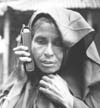|
|
||||
|
Role of
Internet In South Asian Development Technology
- a weapon to
Viewpoint Sundown Madness at Wagah Border
Heritage & Travel
Books
|
|
|
||
|
the-south-asian.com February 2001 |
||||
|
Page 1 of 4 India's contribution to the technology boom is well known.
Indians now run more than 750 technology companies in California's Silicon
Valley. Microsoft's Human Resources Department notes that over 30% of its
programmers are of Indian ancestry. McKinsey & Co. predicts that Indian
software revenues will rise from $5 billion now to nearly $87 billion by the
decade's end. Several U.S. companies founded by Indians are now counted
among the world's most promising Internet start-ups. A growing number of
India IT-diaspora leaders are searching for ways to "give back" to
India, assisting its social needs. Not satisfied simply with investing
capital in companies in India, some are exploring new roles as
philanthropists and as volunteers who could be encouraged to help rethink
India's economic and social development efforts. "It is obvious that dropping a computer into a remote
village will have little positive impact," Akhtar Badshah, Executive
Director of Digital Partners said. "Creating and adding appropriate and
readily understood IT applications could accelerate a lot of excellent
development work being done around the world. We want to identify these
opportunities." South Asian Success Stories Grameen Village Phone, Village Email and Village Internet Bangladesh Grameen Bank's positive impact on the poor has been
documented in many independent studies carried out by external agencies
including the World Bank, the International Food Research Policy Institute (IFPRI)
and the Bangladesh Institute of Development Studies (BIDS). Its success has inspired people and institutions throughout
the world with its success in poverty alleviation. A total of 223 Grameen
replication programs in 58 countries have been established during the last
decade. Taken together, they have reached several hundred thousand poor
borrowers with credit around the world. The Bank has now turned its attention to unleashing the
potential of the new technologies of the Digital Age to benefit the poor.
The banks four technology-and-market based efforts are described as merely
the first steps in working to "unleash the potential of everyone
everywhere." Village Phone This visionary goal will be
achieved one village at a time by giving micro-credit loans- usually
to poor women- to create 68,000 new entrepreneurs known as
"phone ladies." Building on past relationships with
Grameen Bank, customers with a good credit history are allowed to
borrow about $350 from the Bank and purchases a cell phone in order
to provide telephone services to the villagers, making a good living
and paying off the loan. It creates a self-employment opportunity in
each village and provides access to telephones to all. By bringing electronic
connectivity to rural Bangladesh, Village Phone is bringing the
digital revolution to the doorsteps of the rural poor and
unconnected. By being able to connect to urban areas or even to
foreign countries, a whole new world of opportunities is opening up
for the villagers in Bangladesh. Thus, the telephone becomes a
weapon against poverty. "The people of Bangladesh are
a good investment in the future. If you look at Grameen Bank, it has
2.4 million borrowers in 39,000 villages. Ninety-four percent of the
borrowers are women. Ninety-eight percent of the loans are repaid.
And now, with loans for people to buy cell phones, entire villages
are being brought into the Information Age. I want people throughout
the world to know this story." Former US Village Energy |
||||
| Copyright © 2000 [the-south-asian.com]. Intellectual Property. All rights reserved. | ||||
| Home |
 Village
Phone is Grameen's unique method of bringing the information
revolution to the rural people of Bangladesh. There are currently
1425 Village Phones in operation. The
goal is to provide the first phone service to 100 million rural
inhabitants in 68,000 villages by 2007.
Village
Phone is Grameen's unique method of bringing the information
revolution to the rural people of Bangladesh. There are currently
1425 Village Phones in operation. The
goal is to provide the first phone service to 100 million rural
inhabitants in 68,000 villages by 2007.